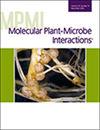求助PDF
{"title":"The <i>Alternaria alternata</i> Mip1/RAPTOR Mediates Virulence by Regulating Toxin Production and Autophagy.","authors":"Yu-Ling Huang, Kuang-Ren Chung, Pei-Ching Wu","doi":"10.1094/MPMI-12-24-0161-R","DOIUrl":null,"url":null,"abstract":"<p><p>The necrotrophic pathogen <i>Alternaria alternata</i> produces a host-selective toxin to attack its host plants. This study characterized the crucial function of the Mip1/RAPTOR ortholog (AaMip1) in toxin production and autophagy formation. AaMip1 physically interacts with the Target of Rapamycin (Tor) protein. In response to nitrogen starvation and hydrogen peroxide (H<sub>2</sub>O<sub>2</sub>), AaMip1 binds to Tor and triggers autophagy and oxidative stress detoxification. Deleting the <i>AaMip1</i> gene resulted in a Δ<i>AaMip1</i> strain that increased sensitivity to various oxidants; decreased the expression of two oxidative-stress-response genes, <i>AaYap1</i> and <i>AaNoxA</i>; and had lower catalase activity than the wild type. Δ<i>AaMip1</i> produced lower levels of ACT toxin than the wild type after a 7-day incubation; however, Δ<i>AaMip1</i> produced tricycloalternarene mycotoxins but not ACT after 21 days. The reduction of Δ<i>AaMip1</i> virulence in the host plant is due to low ACT production, defective H<sub>2</sub>O<sub>2</sub> detoxification, impaired autophagy, and slow growth during invasion. However, AaMip1 plays a negative role in maintaining cell wall integrity and lipid body accumulation. Δ<i>AaMip1</i> had thicker cell walls and emitted brighter red fluorescence after staining with the cell-wall-disrupting agents Congo red and calcofluor white. Δ<i>AaMip1</i> was more resistant to these compounds than the wild type under nutrient-rich conditions. The observed defects in the Δ<i>AaMip1</i> were restored in the complementation strain after re-expressing a functional copy of <i>AaMip1</i>. This study increases our understanding of how <i>A. alternata</i> deals with toxic reactive oxygen species, triggers autophagy formation, maintains normal cell wall integrity, and regulates toxin metabolism via the AaMip1-mediated signaling pathways. [Formula: see text] Copyright © 2025 The Author(s). This is an open access article distributed under the CC BY-NC-ND 4.0 International license.</p>","PeriodicalId":19009,"journal":{"name":"Molecular Plant-microbe Interactions","volume":" ","pages":"610-622"},"PeriodicalIF":3.4000,"publicationDate":"2025-07-01","publicationTypes":"Journal Article","fieldsOfStudy":null,"isOpenAccess":false,"openAccessPdf":"","citationCount":"0","resultStr":null,"platform":"Semanticscholar","paperid":null,"PeriodicalName":"Molecular Plant-microbe Interactions","FirstCategoryId":"99","ListUrlMain":"https://doi.org/10.1094/MPMI-12-24-0161-R","RegionNum":3,"RegionCategory":"生物学","ArticlePicture":[],"TitleCN":null,"AbstractTextCN":null,"PMCID":null,"EPubDate":"2025/7/9 0:00:00","PubModel":"Epub","JCR":"Q2","JCRName":"BIOCHEMISTRY & MOLECULAR BIOLOGY","Score":null,"Total":0}
引用次数: 0
引用
批量引用
Abstract
The necrotrophic pathogen Alternaria alternata produces a host-selective toxin to attack its host plants. This study characterized the crucial function of the Mip1/RAPTOR ortholog (AaMip1) in toxin production and autophagy formation. AaMip1 physically interacts with the Target of Rapamycin (Tor) protein. In response to nitrogen starvation and hydrogen peroxide (H2 O2 ), AaMip1 binds to Tor and triggers autophagy and oxidative stress detoxification. Deleting the AaMip1 gene resulted in a ΔAaMip1 strain that increased sensitivity to various oxidants; decreased the expression of two oxidative-stress-response genes, AaYap1 and AaNoxA ; and had lower catalase activity than the wild type. ΔAaMip1 produced lower levels of ACT toxin than the wild type after a 7-day incubation; however, ΔAaMip1 produced tricycloalternarene mycotoxins but not ACT after 21 days. The reduction of ΔAaMip1 virulence in the host plant is due to low ACT production, defective H2 O2 detoxification, impaired autophagy, and slow growth during invasion. However, AaMip1 plays a negative role in maintaining cell wall integrity and lipid body accumulation. ΔAaMip1 had thicker cell walls and emitted brighter red fluorescence after staining with the cell-wall-disrupting agents Congo red and calcofluor white. ΔAaMip1 was more resistant to these compounds than the wild type under nutrient-rich conditions. The observed defects in the ΔAaMip1 were restored in the complementation strain after re-expressing a functional copy of AaMip1 . This study increases our understanding of how A. alternata deals with toxic reactive oxygen species, triggers autophagy formation, maintains normal cell wall integrity, and regulates toxin metabolism via the AaMip1-mediated signaling pathways. [Formula: see text] Copyright © 2025 The Author(s). This is an open access article distributed under the CC BY-NC-ND 4.0 International license.
互交霉Mip1/RAPTOR通过调节毒素产生和自噬介导毒力。
坏死性病菌互交菌产生一种宿主选择性毒素来攻击其寄主植物。本研究表征了Mip1/RAPTOR同源基因(AaMip1)在毒素产生和自噬形成中的关键功能。AaMip1与雷帕霉素靶蛋白(Target of Rapamycin, Tor)相互作用。在对氮饥饿和H2O2的反应中,AaMip1与Tor结合并触发自噬和氧化应激解毒。删除AaMip1基因后,ΔAaMip1菌株对各种氧化剂的敏感性增加,AaYap1和AaNoxA两个氧化应激反应基因的表达减少,过氧化氢酶活性低于野生型。ΔAaMip1在孵育7天后产生的ACT毒素水平低于野生型;然而,ΔAaMip1在21天后产生三环交替芳烃真菌毒素,但不产生ACT。ΔAaMip1毒力在寄主植物中的降低是由于侵袭期间ACT产量低、H2O2解毒缺陷、自噬受损和生长缓慢。然而,AaMip1在维持细胞壁完整性和脂体积累方面起负作用。ΔAaMip1细胞壁较厚,用细胞壁破坏剂刚果红和白钙染色后发出较亮的红色荧光。在营养丰富的条件下,ΔAaMip1比野生型对这些化合物的抗性更强。在重新表达AaMip1的功能拷贝后,在补体(CP)菌株中恢复了ΔAaMip1中观察到的缺陷。这项研究增加了我们对互花草如何通过aamip1介导的信号通路处理有毒ROS、触发自噬形成、维持正常细胞壁完整性和调节毒素代谢的理解。
本文章由计算机程序翻译,如有差异,请以英文原文为准。

 求助内容:
求助内容: 应助结果提醒方式:
应助结果提醒方式:


